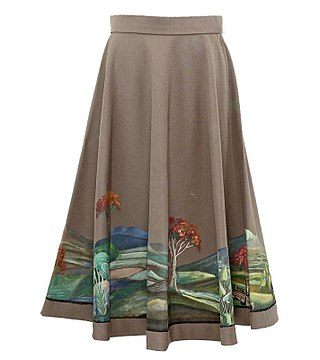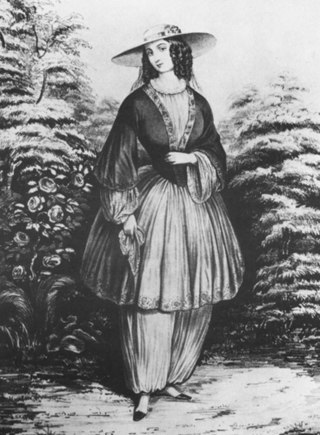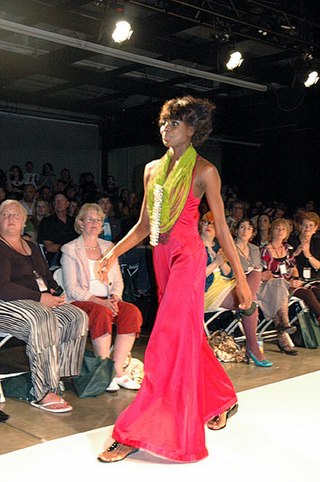
Shorts are a garment worn over the pelvic area, circling the waist and splitting to cover the upper part of the legs, sometimes extending down to the knees but not covering the entire length of the leg. They are called "shorts" because they are a shortened version of trousers, which cover the entire leg, but not the foot. Shorts are typically worn in warm weather or in an environment where comfort and airflow are more important than the protection of the legs.

A skirt is the lower part of a dress or a separate outer garment that covers a person from the waist downwards.

A skort is a pair of shorts with an overlapping fabric panel made to resemble a skirt covering the front and back, or a skirt with a pair of integral shorts hidden underneath.

Paul Poiret was a French fashion designer, a master couturier during the first two decades of the 20th century. He was the founder of his namesake haute couture house.

Fashion in the 1890s in European and European-influenced countries is characterized by long elegant lines, tall collars, and the rise of sportswear. It was an era of great dress reforms led by the invention of the drop-frame safety bicycle, which allowed women the opportunity to ride bicycles more comfortably, and therefore, created the need for appropriate clothing.

A hobble skirt was a skirt with a narrow enough hem to significantly impede the wearer's stride. It was called a "hobble skirt" because it seemed to hobble any woman as she walked. Hobble skirts were a short-lived fashion trend that peaked between 1908 and 1914.

Culottes are an item of clothing worn on the lower half of the body. The term can refer to either split skirts, historical men's breeches, or women's underpants; this is an example of fashion-industry words taken from designs across history, languages and cultures, then being used to describe different garments, often creating confusion among historians and readers. The French word culotte is panties, pants, knickers, trousers, shorts, or (historically) breeches; derived from the French word culot, meaning the lower half of a thing, the lower garment in this case.

Bloomers, also called the bloomer, the Turkish dress, the American dress, or simply reform dress, are divided women's garments for the lower body. They were developed in the 19th century as a healthful and comfortable alternative to the heavy, constricting dresses worn by American women. They take their name from their best-known advocate, the women's rights activist Amelia Bloomer.

Perry Edwin Ellis was an American fashion designer who founded his eponymous sportswear house in the mid-1970s. Ellis' influence on the fashion industry has been called "a huge turning point" because he introduced new patterns and proportions to a market which was dominated by more traditional men's clothing.
A jupe referred to a loose-fitting wool jacket or tunic for men. It was later restricted to an item of women's and children's clothing.

A pleat is a type of fold formed by doubling fabric back upon itself and securing it in place. It is commonly used in clothing and upholstery to gather a wide piece of fabric to a narrower circumference.

Fashion in the 1970s was about individuality. In the early 1970s, Vogue proclaimed "There are no rules in the fashion game now" due to overproduction flooding the market with cheap synthetic clothing. Common items included mini skirts, bell-bottoms popularized by hippies, vintage clothing from the 1950s and earlier, and the androgynous glam rock and disco styles that introduced platform shoes, bright colors, glitter, and satin.
Hammer pants are modified baggy pants, tapered at the ankle with a sagging rise, made suitable for hip hop dancing. They were popularized in the 1980s and 1990s by American rapper MC Hammer. They were inspired by harem pants, which originated in the Middle East, and were introduced to Western fashion by Paul Poiret around 1910.

Fashion from 1910 to 1919 in the Western world was characterized by a rich and exotic opulence in the first half of the decade in contrast with the somber practicality of garments worn during the Great War. Men's trousers were worn cuffed to ankle-length and creased. Skirts rose from floor length to well above the ankle, women began to bob their hair, and the stage was set for the radical new fashions associated with the Jazz Age of the 1920s.

Trousers, slacks, or pants are an item of clothing worn from the waist to anywhere between the knees and the ankles, covering both legs separately. In the United Kingdom, the word pants generally means underwear and not trousers. Shorts are similar to trousers, but with legs that come down only to around the area of the knee, higher or lower depending on the style of the garment. To distinguish them from shorts, trousers may be called "long trousers" in certain contexts such as school uniform, where tailored shorts may be called "short trousers" in the UK.

A fashion boot is a boot worn for reasons of style or fashion. The term is usually applied to women's boots. Fashion boots come in a wide variety of styles, from ankle to thigh-length, and are used for casual, formal, and business attire. Although boots were a popular style of women's footwear in the 19th century, they were not recognized as a high fashion item until the 1960s. They became widely popular in the 1970s and have remained a staple of women's winter wardrobes since then.

Palazzo pants are long unisex pants cut with a loose, extremely wide leg that flares out from the waist.

An overskirt is a type of women's short skirt which is draped over another garment, such as a skirt, breeches, or trousers. Although peplum is often used as another term for overskirt, it should not be confused with the peplos or "peplum dress", which was worn in ancient Greece.

Turkish şalvar, Turkish trousers or dimiye are traditional baggy trousers gathered in tightly at the ankle. They are part of Turkish folk dress.

Jeanne Victorine Margaine-Lacroix was a French couturier of the early 20th-century. The House Margaine-Lacroix is mainly known today for having revolutionized the world of fashion by creating the so-called Sylphide or Tanagréenne dress, cut to be worn without a corset.




















